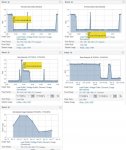We just had our pool completed, and get the luxury of watching it until next year because I'm not a polar bear. The kids did get to swim in it a day or two right before one of the earliest cold fronts in South Texas blew in. I wanted to post some results I've seen with the Hayward Variable speed units. When I ran electric for the pool equipment, I wired in a 100 amp meter service behind my primary residential meter so I could tell exactly what this pool is costing me. (bad idea to know that now)
We have a 1.85 hp Hayward TriStar variable speed on our pool and a 1.25 hp single speed on our water features. We kicked it on for the first time on November 11th full speed. On November 14th I cleaned the filters and on November 15th, I changed the run times for 4-5 hours on high speed and the remainder of the day on low speed.
Top-left graph shows the pool pump demand for full speed. If it ran non-stop that would be 1.57 x 24 hr = 37.68 kwh/day. The top-right graph shows the pool pump demand running at 50% which running non-stop would be .23 x 24 hr = 5.52 kwh/day.
The middle-left graph shows the pool pump and water feature pump kicking on yesterday morning due to the freeze protection. At approximately 5 am it kicked on and then again around 6:45 am. Combined kw for both the pool at full speed and water feature pump is 2.94 kw. The middle-right graph is the pool pump running non-stop until I changed the settings to 50% for a majority of the day. The bottom-left graph shows the KWH/day usage for the pool pump running non-stop until November 14th where I cleaned the filters and on November 15th where I changed the schedule.
Granted the water flow is relatively low on 50%, you can see the energy savings if you can still turn the water over. I plan to play around with the different % on high speed to see what the demand looks like on those as well. I may never run it on high speed if I can get the turn over and have savings on the electric meter.
Hope this is beneficial to others. Now to figuring out this water chemistry and I'll be happy.

We have a 1.85 hp Hayward TriStar variable speed on our pool and a 1.25 hp single speed on our water features. We kicked it on for the first time on November 11th full speed. On November 14th I cleaned the filters and on November 15th, I changed the run times for 4-5 hours on high speed and the remainder of the day on low speed.
Top-left graph shows the pool pump demand for full speed. If it ran non-stop that would be 1.57 x 24 hr = 37.68 kwh/day. The top-right graph shows the pool pump demand running at 50% which running non-stop would be .23 x 24 hr = 5.52 kwh/day.
The middle-left graph shows the pool pump and water feature pump kicking on yesterday morning due to the freeze protection. At approximately 5 am it kicked on and then again around 6:45 am. Combined kw for both the pool at full speed and water feature pump is 2.94 kw. The middle-right graph is the pool pump running non-stop until I changed the settings to 50% for a majority of the day. The bottom-left graph shows the KWH/day usage for the pool pump running non-stop until November 14th where I cleaned the filters and on November 15th where I changed the schedule.
Granted the water flow is relatively low on 50%, you can see the energy savings if you can still turn the water over. I plan to play around with the different % on high speed to see what the demand looks like on those as well. I may never run it on high speed if I can get the turn over and have savings on the electric meter.
Hope this is beneficial to others. Now to figuring out this water chemistry and I'll be happy.


